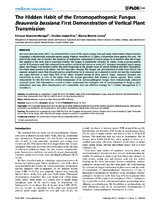The Hidden Habit of the Entomopathogenic Fungus Beauveria bassiana: First Demonstration of Vertical Plant Transmission
Autor
Quesada-Moraga, Enrique
López-Díaz, Cristina
Landa, Blanca B.
Editor
Public Libray of Science (PLOS)Fecha
2014Materia
Beauveria bassianaVertical plant transmission
METS:
Mostrar el registro METSPREMIS:
Mostrar el registro PREMISMetadatos
Mostrar el registro completo del ítemResumen
Beauveria bassiana strain 04/01-Tip, obtained from a larva of the opium poppy stem gall wasp Iraella luteipes (Hymenoptera;
Cynipidae), endophytically colonizes opium poppy (Papaver somniferum L.) plants and protects them against this pest. The
goal of this study was to monitor the dynamics of endophytic colonization of opium poppy by B. bassiana after the fungus
was applied to the seed and to ascertain whether the fungus is transmitted vertically via seeds. Using a species-specific
nested PCR protocol and DNA extracted from surface-sterilised leaf pieces or seeds of B. bassiana-inoculated opium poppy
plants, the fungus was detected within the plant beginning at the growth stage of rosette building and them throughout
the entire plant growth cycle (about 120–140 days after sowing). The fungus was also detected in seeds from 50% of the
capsules sampled. Seeds that showed positive amplification for B. bassiana were planted in sterile soil and the endophyte
was again detected in more than 42% of the plants sampled during all plant growth stages. Beauveria bassiana was
transmitted to seeds in 25% of the plants from the second generation that formed a mature capsule. These results
demonstrate for the first time the vertical transmission of an entomopathogenic fungus from endophytically colonised
maternal plants. This information is crucial to better understand the ecological role of entomopathogenic fungi as plant
endophytes and may allow development of a sustainable and cost effective strategy for I. luteipes management in P.
somniferum.

